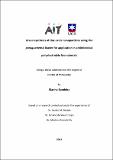| dc.contributor.advisor | Devine, Declan M. | |
| dc.contributor.advisor | da Silva Crespo | Janaina |
| dc.contributor.advisor | Roesch-Ely | Mariana |
| dc.contributor.author | Bandeira, Marina | |
| dc.date.accessioned | 2022-07-06T10:56:53Z | |
| dc.date.available | 2022-07-06T10:56:53Z | |
| dc.date.copyright | 2021 | |
| dc.date.issued | 2021 | |
| dc.identifier.citation | Bandeira, M. (2021). Green synthesis of zinc oxide nanoparticles using Ilex paraguariensis leaves for application in antimicrobial polyelectrolyte biomaterials. Thesis (Doctor of Philosophy - PhD). Athlone Institute of Technology. | en_US |
| dc.identifier.uri | http://research.thea.ie/handle/20.500.12065/4019 | |
| dc.description.abstract | This research aims to develop and characterize antimicrobial polymer
biomaterials containing zinc oxide nanoparticles (ZnONPs) obtained using Ilex
paraguariensis (IP) leaf extract by green synthesis. The biomaterials were investigated
for biomedical device coating and tissue regeneration applications, considering that
infections are one of the major complications in this field. The biomaterials were
synthesized using the polyelectrolytes polyallylamine hydrochloride (PAH) and
polyacrylic acid (PAA) and characterized according to their morphology, composition,
and antimicrobial activity. The green synthesis of ZnONPs was optimized by evaluating
the influence of ethanolic and aqueous plant extract and the zinc source on the
morphological properties of the nanomaterial. Overall, ZnONPs exhibited hexagonal
crystalline structure while the size and shape varied depending on the extract and zinc
salt used. The most uniform and smallest ZnONPs were obtained using ethanolic
extract and zinc nitrate, being spherical in shape and with a diameter of ̴18nm. An
investigation of the mechanism route for the green synthesis indicated that the
formation of ZnONPs occurred due to the complexation of Zn(II) ions by antioxidants
compounds present in the IP extract and further thermal degradation of the
complexes. Cytotoxic analysis showed that L929 cell viability decreased in a dose dependent manner for all ZnONPs samples. However, the nanomaterial with reduced
size and uniform shape exhibited no cytotoxic effects up to a concentration of 10 μg
mL-1 and was chosen to be incorporated in the polymeric biomaterials. Gram-positive
bacteria were more vulnerable to the ZnONPs than Gram-negative, presenting a
minimum inhibitory concentration of 45 μg mL-1
, while the Gram-negative bacteria
showed only 10% inhibition at the same concentration. The thin films were
characterized according to their morphology, ZnONPs content, and antimicrobial
activity. The film composition was found to be dependent on the PAH pH and the IP
concentration, where a more basic pH and lower IP extract concentration resulted in
higher adsorption of ZnONPs, following a linear mathematical model. The thin films
displayed no significant antimicrobial inhibition; however, many possibilities were
addressed for this outcome. Conversely, the electrospun fibres containing ZnONPs
presented a high antimicrobial activity against both S. aureus and E. coli bacteria
strains, which is related to a higher content of ZnONPs. Also, morphological analysis of
the fibre scaffold showed a three-dimensional structure formed by uniform fibres with
a 230 nm diameter that mimics the extracellular matrix of natural tissue. Thus, ZnONPs
were successfully synthesized using a green synthesis route and incorporated in two
different biomaterials. While further studies need to be performed for the
development of the thin film, the electrospun fibres showed promising properties for
wound dressing applications, | en_US |
| dc.format | PDF | en_US |
| dc.language.iso | eng | en_US |
| dc.publisher | Athlone Institute of Technology | en_US |
| dc.rights | Attribution-Non-Commercial-Share-Alike-4.0 International | * |
| dc.rights.uri | http://creativecommons.org/licenses/by-nc-sa/4.0/ | * |
| dc.subject | Zinc oxide nanoparticles | en_US |
| dc.subject | Antimicrobial | en_US |
| dc.subject | Polyelectrolyte biomaterials | en_US |
| dc.subject | Ilex paraguariensis leaves | en_US |
| dc.title | Green synthesis of zinc oxide nanoparticles using Ilex paraguariensis leaves for application in antimicrobial polyelectrolyte biomaterials | en_US |
| dc.type | info:eu-repo/semantics/doctoralThesis | en_US |
| dc.contributor.affiliation | Athlone Institute of Technology | en_US |
| dc.identifier.orcid | https://orcid.org/ 0000-0003-3739-4421 | en_US |
| dc.rights.accessrights | info:eu-repo/semantics/openAccess | en_US |


